Homemade Italian bread is actually very easy to make and tastes delicious! While you could buy a loaf of Italian bread from the grocery store, baking bread is fun and satisfying. Warm, toasty bread from the oven is pure comfort food.
I love my 1963 homemade white bread for sandwiches and everything peasant bread for snacking, but this Italian loaf is perfect with a bowl of spaghetti, or alongside a plate of my crockpot roast beef!

Italian Bread Recipe
There’s a definite difference between French bread and Italian bread. Most of the general population either doesn’t know or simply doesn’t care, but there are differences nonetheless.
Basically though, French bread only uses flour, yeast, salt, and water. In fact, French law states that added oils or fats are prohibited. A French loaf is usually long and thin, while an Italian loaf is shorter and wider.

Expert Tips & FAQs
In this section I like to provide tips and recommendations about the different ingredients used. I also try to answer questions about substitutions. You will find the full list of ingredients with measurements in the printable recipe card at the end of this post.
- You can use the packets of active dry yeast available at any grocery store. I bake a lot of bread, so I prefer to by SAF instant yeast in larger packages.
- When a bread recipe calls for warm water, the temperature should be around 110 degrees F. If the water is too hot it will kill the yeast, and too cold will delay the rise process.
- You’ll also use hot water in this recipe, but since you are mixing it with other ingredients before adding the yeast mixture it will be fine. You want hot tap water, not boiling water.
- This recipe calls for vegetable oil, but olive oil can also be used.
- We are using all-purpose flour, white not wheat, to make this bread.
You can freeze the dough for up to 3 months. If kept in the fridge, the yeast will continue to grow, even if it’s slowly. This can be done for about a day, but I wouldn’t do it much longer than that. Wrap the dough tightly in plastic wrap and store in freezer bags. When ready to bake, remove from the freezer and thaw at room temperature. It will take about 4 hours to thaw. Then bake according to the recipe.
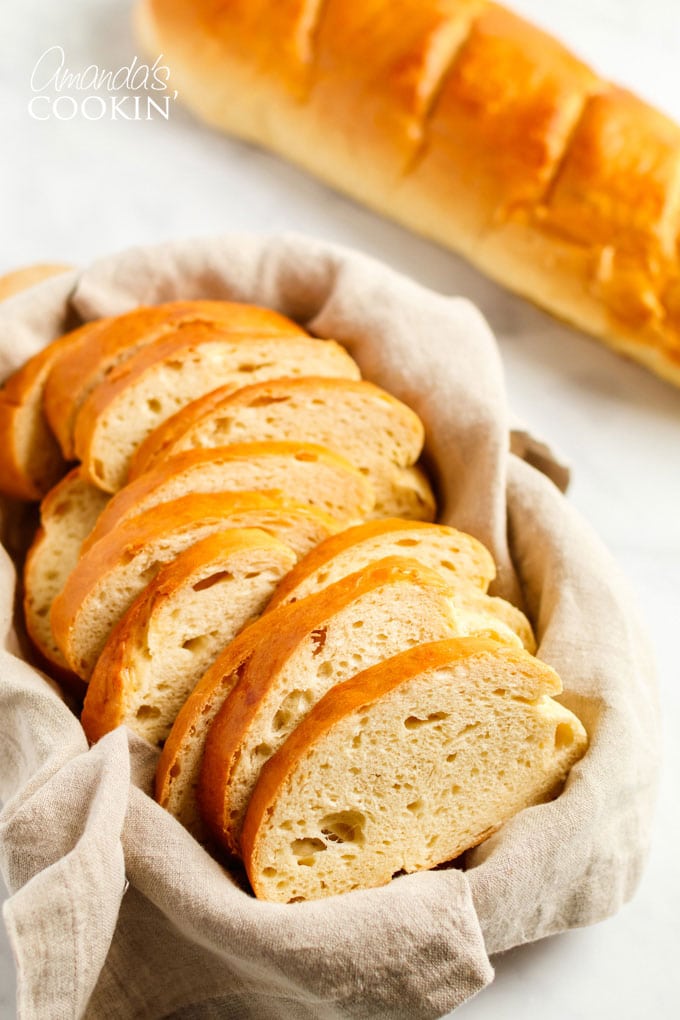
Helpful kitchen tools:
- Mixing bowls
- Stand mixer or hand mixer
- Baking sheets
- Wire cooling rack
- Pastry brush
- Rolling pin
- Bread knife
Bread Machine instructions are at the end!
How to Make Italian Bread
- Dissolve yeast, 1/2 cup warm water, and 1/2 teaspoon granulated sugar in a small bowl.
A NOTE ABOUT YEAST: You can use either active dry yeast or instant yeast. If you use active dry yeast it needs to be proofed in order for it to be reactivated. Instant dry yeast doesn’t need proofing. Active dry yeast must be reactivated by proofing in warm water, or the bread won’t rise properly. This process is to “prove” that the yeast is still alive.
- In a large bowl or stand mixer, combine 2 cups hot water, 3 tablespoons granulated sugar, the salt, and the oil. Add 3 cups of flour to the mixture in this large bowl/mixer and mix well.
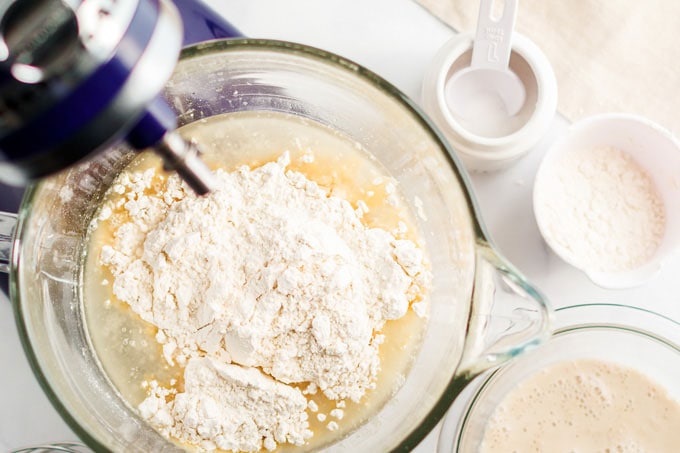
- Stir in yeast mixture.
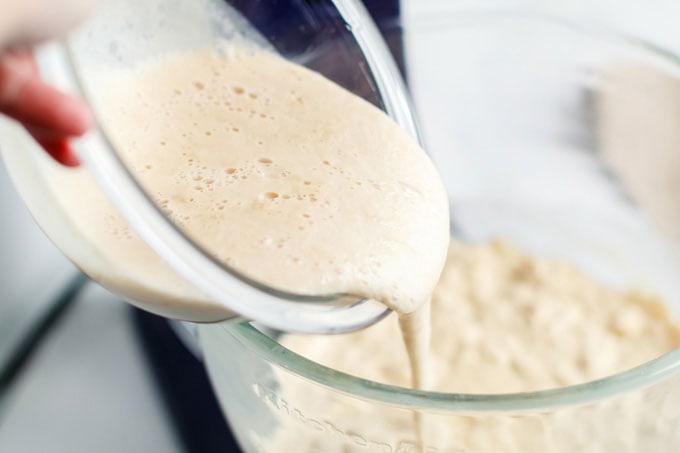
- Add 2 – 3 cups more flour and mix until well blended. (At this point your dough will still be quite sticky).

- Leave in bowl, cover with a towel and let rise for 1 hour. (If using a mixer, remove the bowl from the mixer and cover it with a towel. Otherwise your paddle attachment or dough hook will get covered in dough when it rises).
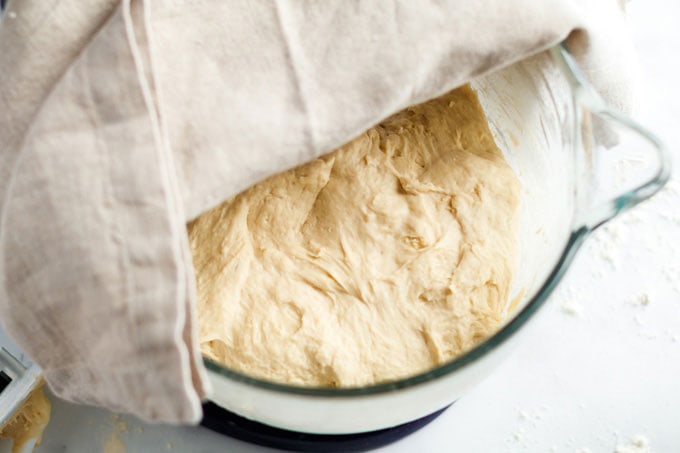
- Divide dough into 2 (or 3 if you want smaller loaves) pieces.
NOTE: This dough does not require kneading.
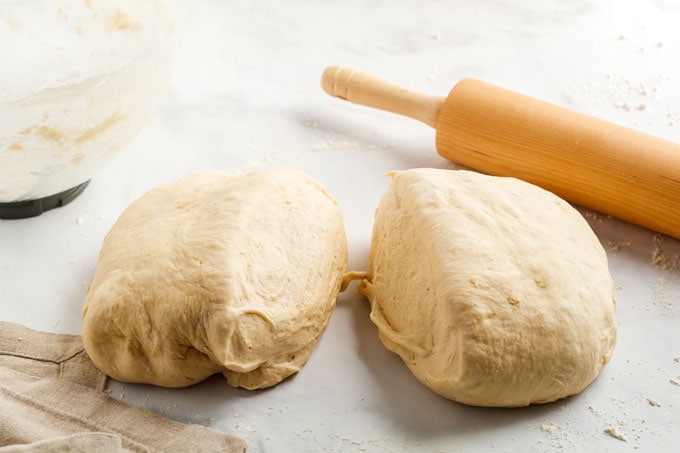
- Roll out each piece on a floured surface into the length desired then roll up length wise like a jelly roll.
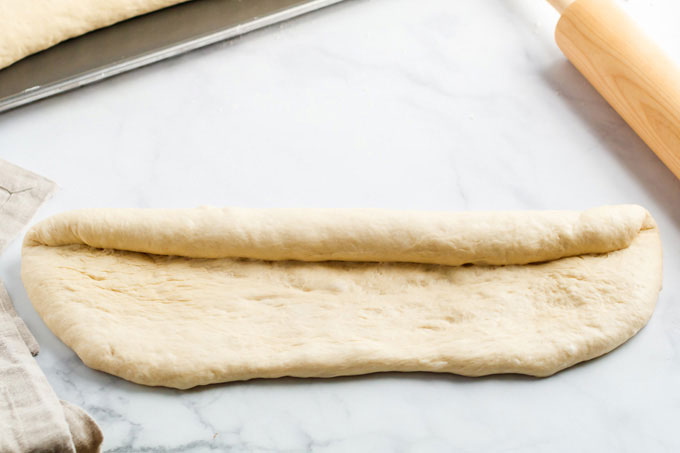
- Put on a greased cookie sheet, sealed side down, and tuck the ends under. Slash the top diagonally across the top every couple of inches with a sharp knife.
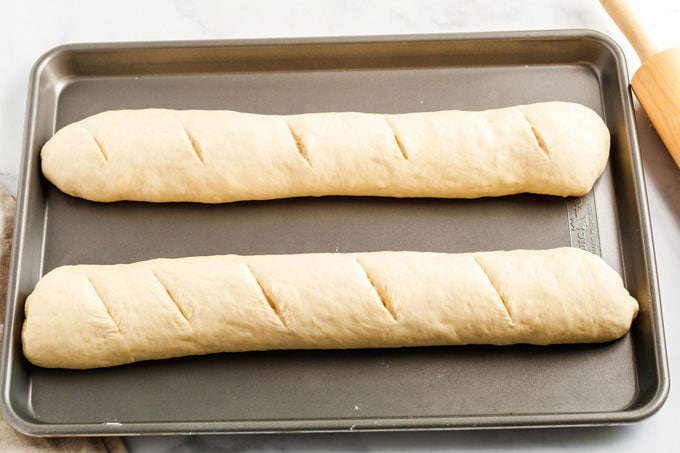
- Cover and let loaves rise 30 more minutes.
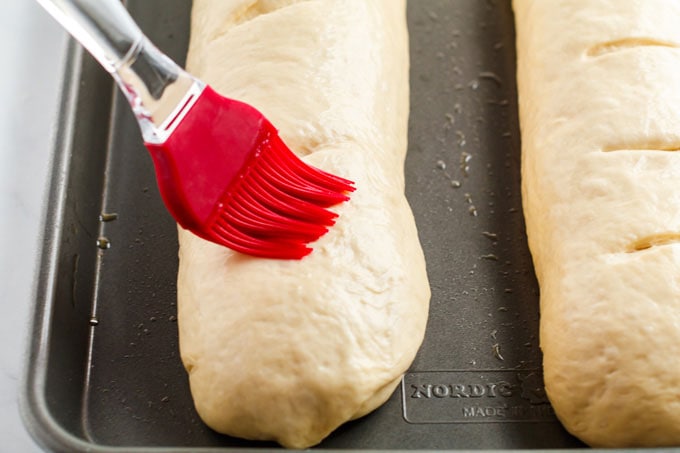
- While loaves are rising, preheat oven to 400 degrees Fahrenheit.
- Whisk the egg white and brush over the top of loaves.
- Bake for 25 – 30 minutes.

How to Make Italian Bread in a Bread Machine
Several people have asked if this Italian bread can be prepared in a bread machine. We were able to test it successfully and have provided the instructions below. Please note, the preparation of the dough is in the bread machine, but you will still remove the dough, form a loaf, and bake it in your conventional oven.
- Using the printable recipe below, cut the ingredients in half, and eliminate the water and sugar step used for proofing the yeast.
- Put 1 cup of water (110 F) and 1/4 cup oil in the bread machine bucket (make sure the paddle is on).
- Add 4 1/2 teaspoons sugar and 1 1/2 teaspoons salt.
- Gently add 3 cups flour over the water mixture so that it is all covered.
- Place 2 1/4 teaspoons (one packet) of yeast on top of flour with nothing else touching it.
- Place bucket in bread machine and enter dough cycle.
- When it beeps, take out and roll dough, adding more flour if needed.
- Roll up (follow instructions in printable recipe for forming loaf) and place on baking sheet, add slashes to top, and cover with towel to let rise (again, according to recipe).
- Brush with egg white and bake at 400 F (see recipe instructions below).
How to Enjoy this Italian Bread
There are plenty of dinners that we like to eat this homemade bread with, and they aren’t all Italian meals! I’ve been known to sop up the juices of my favorite pork sirloin roast using a hunk of this bread.
A big bowl of Italian Sausage Tomato Orzo Soup or my Cheddar Cheese Potato Soup screams for a piece of warm, buttered bread. It’s also amazing with this Zuppa Toscana for those Olive Garden fans out there! Another dinnertime favorite is this Chicken Cacciatore, and it’s great to have a hunk of bread for dipping into the sauce.
Try our new Crockpot Lasagna, it would be perfect with this bread!

Need more ideas? Find all my dinner recipes here!
What Our Readers Are Saying
Never baked bread before? Want to make sure before you invest the time and ingredients? Here’s just a small sampling of what our readers are saying about this recipe! You can find more reviews in the comments down below!
“I have made this twice and it is very tasty, good crust and soft inner not dense , very good flavor, I have been baking bread for 40 years, this is in the top five, Thanks.” ~ Thomas
“By far one of the best and easiest bread recipes I have come across!! Dough comes out perfect and is so easy to roll!! So glad I came across this recipe it’s a game changer.” ~ Tracy
“This bread was so, so delicious! I am proud of myself for going through with it. I was scared to do it and usually need video ( visual learner ) but went ahead and one of the two loaves is already gone! I wish I could attach a pic! I will make this over and over!” ~ Desiree
“I never post reviews… but after making this, I had to!!! I only had bread flour, so used that… but that was the only deviation. I followed the recipe exactly. The bread came out PERFECT! Crispy outside and moist inside. This is some of the best bread I’ve ever made. It will definitely be made again. Thank you!!” ~ Terri
“‘This is a million times better than store bought bread’
‘You have to make this every time we have pasta now’
‘Nom nom nom…’Feedback from my family after serving them this bread for dinner. Excellent recipe!” ~Dave
“OMG! I made this bread today and have to say this is the BEST bread I have ever made, and I’ve tried a lot of recipes! It was very light and fluffy yet just crispy enough on the crust. The only changes I made were I used bread flour and only used 2.5 tablespoons of the sugar instead of three. Thank you for sharing this! I am throwing away all my other bread recipes!” ~ Nadine
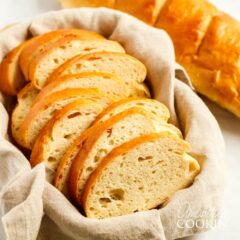
Homemade Italian Bread
IMPORTANT – There are often Frequently Asked Questions within the blog post that you may find helpful. Simply scroll back up to read them!
Print It Pin It Rate ItIngredients
- 1 ½ tablespoons active dry yeast 2 packets
- ½ cup warm water
- ½ teaspoon granulated sugar
- 2 cups hot water hot to the touch, not boiling
- 3 tablespoons granulated sugar
- 1 tablespoon salt
- ½ cup vegetable oil
- 5-6 cups all-purpose flour add more if needed to get to a pliable dough
- 1 large egg white for brushing on loaves
Before You Begin
- If your dough is still super sticky, you can add small amounts of flour until the dough just comes together.
- You can use the packets of active dry yeast available at any grocery store. I bake a lot of bread, so I prefer to by SAF instant yeast in larger packages. If you use active dry, just follow the instructions in the recipe and let it sit for a few minutes to proof (it will get a little foamy).
- When a bread recipe calls for warm water, the temperature should be around 110 degrees F. If the water is too hot it will kill the yeast, and too cold will delay the rise process.
- Use regular white granulated sugar for this recipe.
- In a separate step, you’ll also use hot water in this recipe. Since you are mixing it with other ingredients before adding the yeast mixture it will be fine. You want hot tap water, not boiling water.
- Regular everyday table salt is used, not Kosher or sea salt.
- This recipe calls for vegetable oil, but olive oil can also be used.
- We are using all-purpose flour, white not wheat, to make this bread.
Instructions
- Dissolve yeast, 1/2 cup warm water, and 1/2 teaspoon granulated sugar in a small bowl.
- In a large bowl or stand mixer, combine 2 cups hot water, 3 tablespoons granulated sugar, the salt, and the oil. Add 3 cups of flour to the mixture in this large bowl/mixer and mix well. Stir in yeast mixture.
- Add 2 – 3 cups more flour and mix until well blended. (At this point your dough will still be quite sticky). Leave in bowl, cover with a towel and let rise for 1 hour. (If using a mixer, remove the bowl from the mixer and cover. Otherwise your paddle attachment or dough hook will get covered in dough when it rises). NO KNEADING IS REQUIRED.
- After the rise, if the dough is too sticky to handle, add more flour until its workable. For some people this can be up to a cup or more! Just don't dry out the dough. Add by quarter cupfuls until its workable.
- Divide dough into 2 (or 3 if you want smaller loaves) pieces. Roll out each piece on a floured surface into the length desired then roll up lengthwise like a jelly roll. If it's still too sticky, add more flour until it's workable but not dry.
- Put on a greased cookie sheet, sealed side down, and tuck the ends under. Slash the top diagonally across the top every couple of inches with a sharp knife.
- Cover and let loaves rise 30 more minutes.
- While loaves are rising, preheat oven to 400 degrees Fahrenheit.
- Whisk the egg white and brush over the top of loaves.
- Bake for 25 – 30 minutes.
Nutrition
This recipe was originally published here on January 28, 2009
Amanda Davis
Latest posts by Amanda Davis (see all)
- Roasted Turkey - November 14, 2024
- Pumpkin Cinnamon Chip Cookies - November 11, 2024
- Deviled Eggs - November 4, 2024

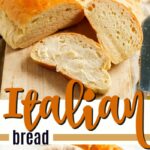
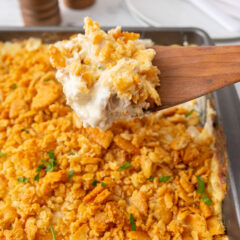
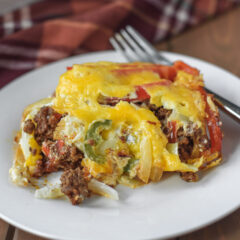
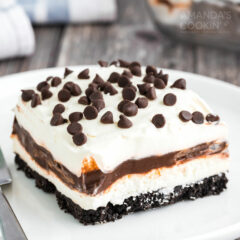






Krystle Parker says
This bread is my go to bread, first bread I really really love, it’s super versatile, I love sometimes adding herbs to the top of it, or eaten with fresh herbed butter. Today I am making the bread for Lammas with wheat instead of white, unsure of how it will turn out but I’m pretty confident it will be just fine. I plan on eating it with butter and apple butter. Thank you for sharing!
Erik says
First off I would like to say to the negative comments I have read regarding this recipe they definitely did something wrong. I just finished making this bread recipe and the only thing I did different was use olive oil in place of vegetable oil and it is definitely fantastic recipe ! Is going into my saved for sure. P.s I’m by no means a baker.
Maria says
Made this several times now, first few tries were not so great, but now I’m getting the hang of when the dough feels “right”. Question: When do you divide the dough and freeze half of it? After the first rise? Please add this info to your “freeze” directions. Thank you!
Laurie says
Adding to my earlier starting review:
The bread grew enormously in the oven. I had zero blah bread and zero “too yeasty” bread. It was very flavorful and with just the right amount of sugar to salt. Great flavor in such a short time and little effort. The texture of the bread interior was soft straight through uniformly to the thin crust. Which is what I’d hoped for, both texturally, and crust wise.
Because I was using 100% 00 flour, I adjusted the recipe just a tinge. Adding the initial flour by whisking it slowly into the wet ingredients, it was much like a poolish, and I added the next 2 cups with one hand in my large bowl, adding a 1/2 cup more and mixing it gently but thoroughly. I was surprised at the very stickiness, but I covered it and sat it for an hour. It bubbled up gorgeously, and I must confess I’m still using some active dry yeast I got in bulk 4 YEARS ago —> and keep in a freezer. I made up around 3 million – hahaha – little tubs in the same amount as 1 packet of active dry yeast. I proofed it, wondering if it had life left in it and boom, hugely bloomed.
After first rise it was so wet still, and I attribute that to my flour. Added just under 3/4 cup more 00, wondering if I should’ve used AP by then, for body, since the flour is much lower in protein and gluten than even AP, I kneaded it in the bowl for only 2 minutes. I don’t care for the more raggedy no knead breads much anyway but this would’ve been impossible otherwise to shape. It was still greatly loose and soft. It teetered on its ability to remain a loaf! LOL I loved that. Slashed and baked off 22 minutes, 2 very huge loaves – which I completely forgot to egg wash. Ugh. I LIKE the texture and shine but just forgot. Oh well, a first attempt, and using ingredients that varied.
The loaves rose so well that even on my half sheet laid diagonally with inches between them, they touched and melded, lol. Simple slice and perfect loaves. The forgotten egg wash was my only let down as I found my crust to be a bit crumbly and dry, but it was THE crust I’m looking for, no doubt. My husband loves this bread, we ate some warm from the oven w/our supper.
So thank you for this unique and really FUN technique toward a whole lot of tasty, soft and crispy crusted Italian bread! Very easy to follow recipe guide and expecting you to observe, understand, and resolve as required in your kitchen. I love that.
.
Laurie says
Amanda,
I’m making 2 loaves right now and I can’t wait to see them out of the oven. I’m using 00 flour and a mix of olive and peanut oil. Olive alone is strongly flavored for me. Peanut has no flavor. What I must say right now, though, is that this is the best recipe I’ve seen for any bread, it’s so brilliantly written FOR the mind of a baker.
First it’s not so easy to find a recipe for a thin crust, soft interior Italian bread using 00 flour! A million pizza and focaccia recipes but bread? Meh those I’ve seen are not what I’m looking for. They’ll say are you looking for a chewy thick crust and dense, delicious dough? This is it! But nooo that’s a rustic French. And they use AP as here. Peering at the photo here this is what I’m looking for. I’m not an accomplished baker. I’ve made many loaves of Julia Child’s White bread type good delicious yeast sandwich breads for my family over my lifetime, but that’s it. Been wanting to try my favorite bread of all time and I’m using this recipe. It’s a great, involving and very very confidence building recipe, as you eyeball it. You feel it. You get to know it as it’s developing. Not just by rote.
Now. It’s doing the 30 minutes rest now. I’ve slashed them and they look gorgeous, and that 00 flour sure has a luxurious texture! I’m off to order more, and will return to give my final remarks later, but so far this recipe is the best. THANK YOU! I was about to use the Cento flour recipe but find this much more my style and I think the loaves more to my liking. So happy.
Javier Carriedo says
This recipe does not give a lot of direction. The bread came out extremely dense because I was not sure how much flour to add extra and I did not know what I was looking for the dough to look and feel like. “Workable” is very different for different people. I began making bread with high hydration sourdough breads so workable for me is still somewhat tacky and apparently that’s not correct because I as previously stated it came out incredibly dense. After messing up, I know know how to fix the issue, but if it weren’t for previous experience making bread I would not know. This recipe is for someone who knows how the dough should feel because if not “workable” can mean many things.
Kimberly Budd says
Ok, I never review recipes. If they don’t work out I just don’t make ’em again. This one has got so much trash talk in the comments though I had to put my 2 cents in. If you need, deep down in your soul, to follow a set of precise steps that will lead to a definite result hen no, maybe this isn’t the one for you dawg. This is however, exactly the bread recipe I needed. I’m a novice baker and I live at 6250 ft above sea level. Two factors conspiring to spoil all my attempts at baking. What this recipe did for me was to take the focus off following steps and put it on paying attention to how things looked, felt, tasted. It made it ok to experiment instead of just to follow instructions, fail, and blame the instructions. I have made many perfect golden loaves from this recipe, tweaking it a little each time until I came up with a permutation that gives me one sandwich sized loaf that is perfect every time. I’ve made with bread flour, all purpose flour, with instant yeast and regular yeast. I’ve eventually settled into half bread flour/half all purpose. I halve all the ingredients but use 1.5 cups of water total and the flour ends up being around 4 cups but after 3 I just add it a spoonful at a time until I have that slightly sticky consistency. It’s the first time I’ve been successful at baking bread so THANK YOU AMANDA.
Amanda Formaro says
Thank you so much for this Kimberly! Great review and I’m so happy it worked out for you!!
Alejandra says
high altitude people listen!!! i made the bread and i was confused, as the dough was very liquidity, i added about 1 more cup of flour (give or take i wasn’t really counting) and the dough turned out fine! my rule of thumb is to just add flour until the dough stops sticking to the sides of the bowl. sticking to the sides of the bowl does not mean floury dough ball, it means wet dough that when pulled won’t stick to the sides (learned this the hard way lol). everyone lives in different places, so just use your gut and everything should turn out fine!
marian davis says
I loved this recipe, it just came out perfect, I loved that it made two, so I can give one away, I baked two today, and I’m making more tomorrow, Thanks Amanda!
Rosa says
Love, love this recipe. I’ve made it about 10 times since coming across it back in April. My daughter is very picky when it comes to bread and she loves this bread. It’s light, fluffy and even the next day is still quite fresh…it is my go to bread when I make my pea stew. I shared the recipe with my mom in Europe and she loves it.
J.Hicks says
Omigosh just made this and it turned out perfect!! Sooo yummy!!
John says
The amount of yeast gives a definite minus factor and overpower. I bake bread in both whole wheat and white but have been trying italian recipes. The overdone yeast is a problem. I suggest just one pack or 2 and 1/4 teas of active dry and waiting longer for doubling and then second rise. You want to taste the bread, not the yeast.
Amanda Formaro says
Interesting, I have never experienced this and have made this literally hundreds of times. Thanks for the feedback though.
Noah says
The recipe is a mess with just too much variation in the ratios. Add 2-3 cups flour then maybe another? As written the dough looked more like a batter. I weighed everything out for accuracy too.
Amanda Formaro says
Sorry you had trouble and refused to follow the direction about adding more flour.
Noah says
I did add more flour and it came out ok. But this recipe might as well just say mix flour and water until you have a dough. I can’t believe this was the top google result there’s much better out there
Jonathan Boeck says
I followed the recipe and it came out extremely dense and excessively crumbly. I think because it does not say to knead the dough. I needed the third try and added 2 tablespoons of dried milk. Made all the difference in the world.
Amanda Formaro says
Sounds like you may have done something wrong. I’ve never experienced this and make this bread all the time. it does not require kneading at all, but I’m glad you were able to correct and save your bread.
Ashley says
There’s always one 🙄
Zori says
This was my first time trying this recipe, and I absolutely love it. I added less salt (2 tsps) and did not do the egg wash – those are just personal preferences of mine. I baked my two loaves in a French bread pan. The bread was exactly what I had been hoping to accomplish and taste.
Barbara says
Fabulous recipe! I made two loaves of what is probably the most delicious bread I’ve ever baked. Thank you!
Sarah Peterson says
Is the salt necessary? My kiddo can’t eat salt so I am hoping to find a no-low sodium homemade option for garlic toast.
Amanda Formaro says
I am quoting this from King Arthur’s Flour as they explain it quite well “When added to bread dough, salt works to tighten the gluten strands that are formed, which makes them stronger. By strengthening these gluten strands, salt enables the dough to hold carbon dioxide more efficiently.”
Eve Johannesson says
I have been making this recipe every week for a couple of months now – we won’t eat any other bread!
I was wondering if it could be made into buns…wish me luck ‘cause I’m trying it today
Amanda Formaro says
I’m sure with a cooking time adjustment they would be great!
Lola says
I added all of the flour before the first rise, and it turned out perfect. Making it for the third time right now.
Emmerson Burson says
I’ve made this twice and neither time was the dough workable at all. Literally so liquidy that my kitchen was an absolute mess. That’s even after adding an extra cup of flour on top of the extra that’s optional in the recipe. It tastes good in the end but it’s just so not worth it.
Amanda Formaro says
Sorry you had trouble. Some people have to add more flour than others as stated in the recipe.
DMc says
made the Italian bread recipe , looked wonderful , but I’ve done something wrong . Was really heavy , not near as good as it looked . Can someone suggest what I’ve done wrong ! The dough was pretty wet when I let it rest for first hour , and had to add flour when I rolled out , maybe it needed to knead flour in more ?
Harrison says
Your “warm water” at the start of the recipe may have been too hot and killed your yeast. Did it rise significantly during the 1 hr wait? I always test the temp of the water before adding yeast — temps of 120 will kill it.